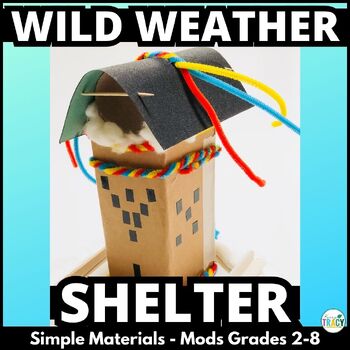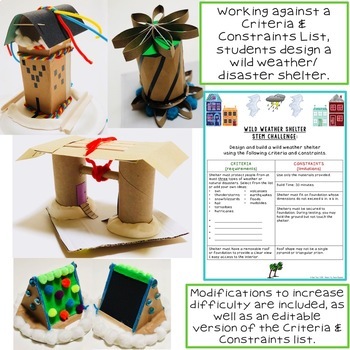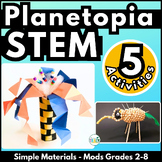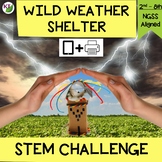Weather STEM Activity | Spring STEM | Natural Disasters STEM Challenge Activity
- Zip
What educators are saying
Also included in
- 52 NGSS-aligned STEM challenge activities to build engagement, critical thinking, & problem-solving all year long! These are easy STEM activities to implement, use simple materials, and include modifications for grades 2 - 8. The basic idea: Students work in partners or groups against criteria &Price $59.99Original Price $184.89Save $124.90
- If your science standards include landforms, plate tectonics, the water cycle, weather, natural disasters, plant parts, plant cells, animal cells, life cycles, and/or heredity & genetics, Planetopia Project STEM Challenges are perfect to engage your students in brain-busting work (disguised as fPrice $9.99Original Price $20.43Save $10.44
- Super-charge your STEM class with 52 high-engagement, critical thinking, problem-solving, NGSS-aligned challenges to take you through the entire year! Modifications are included to make these activities engaging and challenging for students in grades 2 - 8.The basic premise: Students work in partnerPrice $99.99Original Price $372.00Save $272.01
- If you’re looking to apply learning in weather, climate, natural disasters, natural resources & more, this STEM / STEAM challenge is a perfectly engaging way to get the job done joyfully!The basic premise:Students work individually or in partners/groups against a list of criteria and constraintsPrice $6.98Original Price $9.96Save $2.98
Description
If you’re looking to apply learning in weather, climate, natural disasters, natural resources & more, this STEM / STEAM challenge is a perfectly engaging way to get the job done joyfully!
The basic idea:
Students work individually or in partners/groups against a list of criteria and constraints to create a shelter to defend against 3+ types of weather and/or disasters.
This challenge was developed as part of the Planetopia Project, but it can be used as a stand-alone challenge as well.
Note: This the PRINTABLE version. If you prefer the version for use with Google Slides™, you'll want to look at the PAPERLESS VERSION instead.
If you have questions about which version is right for you, please feel free to leave me a question using the product Q&A below.
This resource is also available in the following discounted bundles:
⭐ Planetopia Project STEM Challenge Bundle
⭐ STEM Challenges: Year-Round Mega Bundle
⭐ The Ultimate STEM Challenge Mega Bundle
⭐ Resource includes:
✅ NGSS aligned standards, Grades 2 – 8
✅ Teacher Tips
- Links to a video walk-through of the challenge & my 5-part video series on getting started with STEM challenges
- Premise & Set-up
- Materials and timing
- Modifying Criteria & Constraints to adjust challenge difficulty
- Measuring results
- Post-design extension activities list & links
✅ EDITABLE Student Handouts
- Planning Pages
- Criteria and Constraints list (two editable versions in color and B&W)
- Design Analysis Handouts (in color and B&W in two versions: 4-page expanded room for response and 2-page condensed space version for older students)
- Discussion Questions (in color and B&W)
✅ Extension templates
- Evaporation Diagram
- The Water Cycle Diagram
- Shelter Ratings Activity
- Shelter Superlatives Template
- Weather Graph
- Weather Forecasting Activity Template
- Postcard Writing Templates
- Process flow map
- Create & solve math problems based on designs
Materials you’ll need to do the activity are easily modified. You can select a subset of the materials below and/or add your own ideas. The materials you select will be based on the types of weather/disasters you have your students design for.
Sample/suggested materials for each student or group:
For Building:
- Cardboard scraps / paper plates / small cups
- Craft sticks / wooden coffee stirrers
- Pipe cleaners
- Masking or packing tape
- Cotton
- Sand Paper
- Plastic wrap, bags, or balloons
- Zip ties or string
- Scissors, hole punch and/or nails/screwdrivers
Optional Building Materials:
- Crayola Model Magic or clay
- Hot glue gun
- Foil
- Construction paper / tissue
- Coffee filters
- Pompoms
- Foil
- Paperclips
- Toothpicks
Measuring Results Materials:
- Plastic bin or foil tray (shoebox size works well)
- Water
- Tissue paper
- Thermometers
- Spray bottles
- Fan, hair dryer, or leaf blower
- Cotton balls or batting
- Beads, rice, or marbles
- Molasses or mud
- Gravel, rocks, or sand
You may also like these products:
Related Products
⭐ Earth Day STEM Challenge: New Earth City
⭐ Thanksgiving STEM Challenge: Protect-a-Pilgrim
~~~~~~~~~~~~~~~~~~~~~~~~~~~~~~~~~~~~~~~~~~~~~~~~~~~~~~~~~~~~~~~~~~~~~~~~~~~~~~~~~~~~~~~~~~~~~~~~~~~~~
Video preview music credit:
"Carefree" Kevin MacLeod (incompetech.com)
Licensed under Creative Commons: By Attribution 3.0 License
http://creativecommons.org/licenses/by/3.0/









